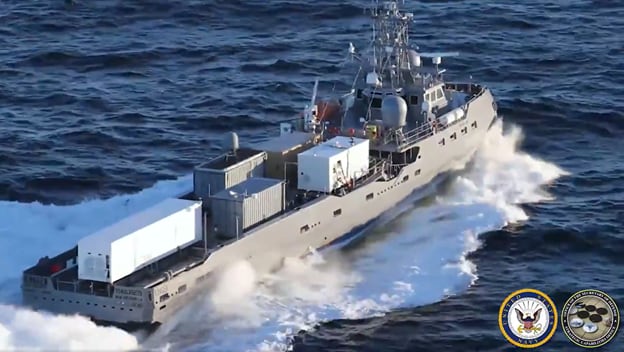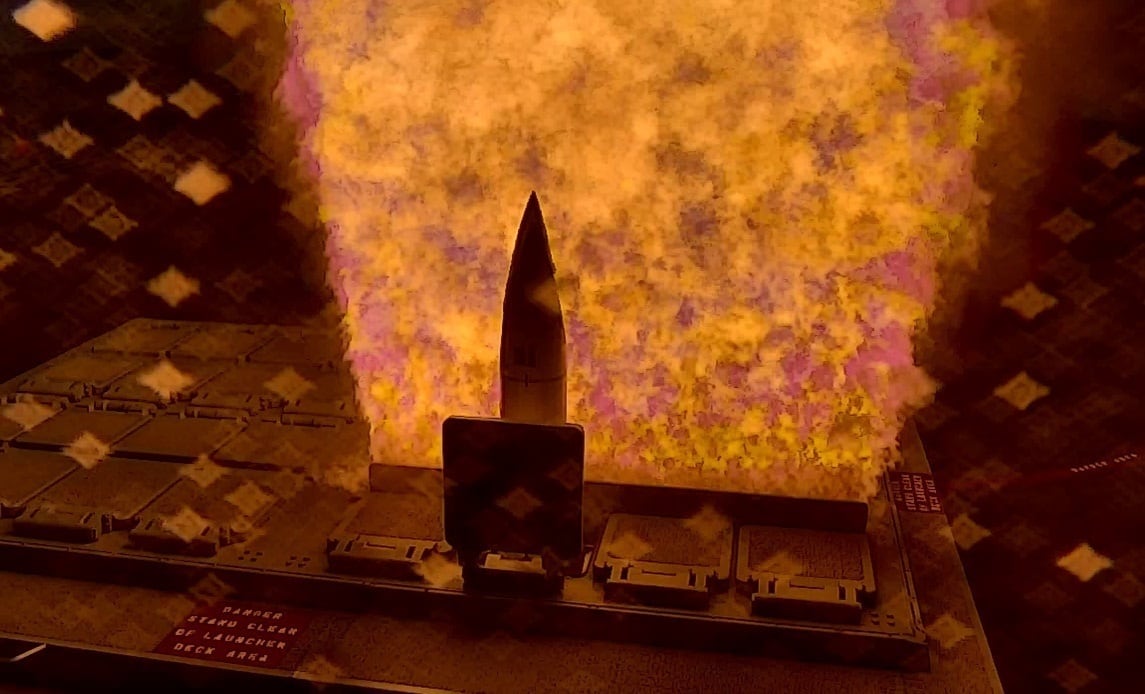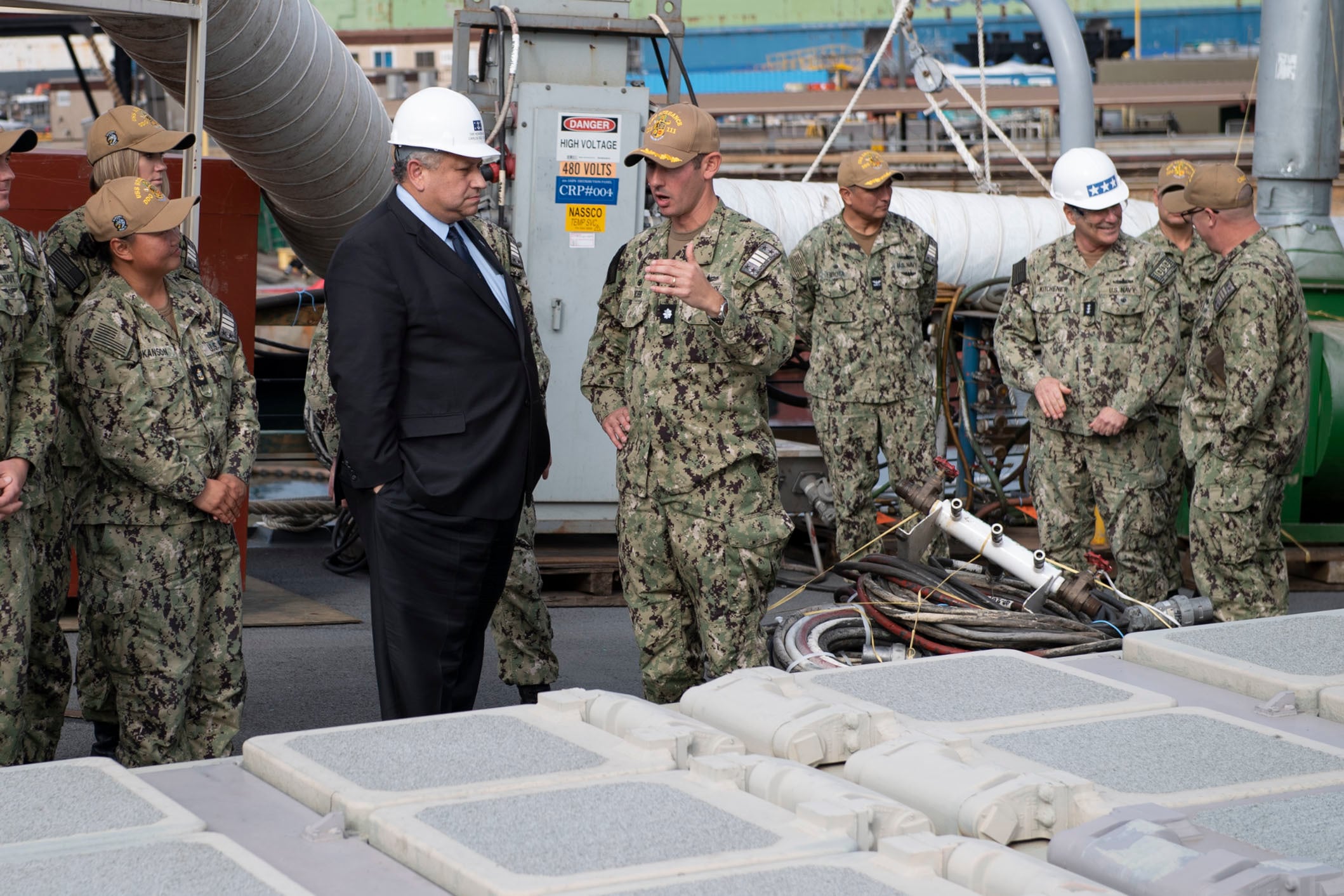WASHINGTON — In early October, the U.S. Navy reloaded a destroyer’s missile tubes using a crane on an auxiliary ship pulled alongside the destroyer, rather than a crane on an established pier.
Reloading a vertical launching system, or VLS, is a challenging maneuver, given the crane must hold missile canisters vertically, while slowly lowering the explosives into the system’s small opening in the ship deck.
It’s also a maneuver the Navy cannot yet do at sea. This demonstration took place while the destroyer Spruance was tied to the pier at Naval Air Station North Island, as a first step in creating a more expeditionary rearming capability.
But in the near future, that same evolution between a warship and an auxiliary vessel could take place in any harbor or protected waters around the globe. One day, it may even take place in the open ocean, thanks to research and development efforts in support of a top priority for the secretary of the Navy.
Carlos Del Toro is eyeing this rearm-at-sea capability as one of a handful of steps the service must take to prepare for conflict in the Pacific; other steps include strengthening logistics capabilities and identifying foreign shipyards that could conduct repairs to battle-damaged ships.
Today, the Navy’s cruisers and destroyers can only load and unload offices at established piers with approved infrastructure. For the Pacific fleet, these reload sites are in Japan, Guam, Hawaii and California.
But in a conflict with China — the Pentagon’s self-declared No. 1 geopolitical threat — these combatants could easily fire all their missiles in just one or two engagements, after which they would leave the fight to reload.
RELATED

But piers in Japan and Guam could be destroyed, or the surrounding area could be contested enough that pierside ships would be too vulnerable. Sailing to Hawaii to reload would take vessels out of the fight for two weeks or more, with a trip to California costing at least three weeks.
For Del Toro, this is unacceptable.
Calling a rearming-at-sea capability “game-changing,” he told a New York audience late last year that “being able to quickly rearm our warships’ vertical launch tubes at sea will significantly increase forward, persistent combat power with the current force.”
A longstanding vulnerability
Del Toro was 18 years into his career as a naval officer when he took command of the destroyer Bulkeley in 2001. By that time, the Navy had lost its ability to rearm destroyers at sea.
The service had such a capability with previous platforms, but as new ships and missiles entered the fleet and the Cold War came to an end, the service opted against devoting resources to developing a new rearming method.
Two decades later, when Del Toro was sworn in as Navy secretary, he immediately began tackling the naval service’s logistics problems.
“Without question, logistics rises to the top in terms of priorities that are necessary — logistics in terms of the forward presence that we’re going to need in the Indo-Pacific, to forward-deploy parts and supplies and troops and everything that we need, in addition to the capabilities that individual ships themselves will need in order to be able to rearm,” he told Defense News on Feb. 17.
He put rearming ships at sea high on the list of logistics-related gaps the Navy must close.
“Over the course of decades, this is something we have actually studied, and now it’s time to make the necessary investments so that we can rearm our cruisers or our destroyers or our future frigates … at sea, should we be called upon to fight a war,” he said.
Maritime operations and naval logistics experts agree.
“Assuming the battle goes on longer than a single missile load, you need to rotate shooters out to reload and return to the scene of battle,” said James Holmes, a former surface warfare officer and the J. C. Wylie chair of maritime strategy at the Naval War College.
“If the fight is in the Taiwan Strait or South China Sea, far from the nearest port that can execute a reload, you are taking combatants off the firing line for a substantial time. We might make that work if we had a huge fleet and plenty of shooters to rotate in; but our fleet is lean in the extreme, in numerical terms,” he added. “We need the most we can get out of every platform, and that means rearming close to the scene of combat and getting back into action quickly.”

Tim Walton, a senior fellow at the Hudson Institute’s Center for Defense Concepts and Technology, who has written extensively on the topic of rearming at sea, said Del Toro is recognizing “the enormous opportunities of new VLS rearming capabilities.”
Indeed, Walton wrote in a 2019 study for the Center for Strategic and Budgetary Assessments that fielding just two or three ships that could rearm cruisers and destroyers in the Western or Central Pacific would, by getting the Navy’s combatants back on station more quickly, add the equivalent of 18 more cruisers and destroyers in the fleet.
“Viewed in this light, a fleet VLS rearming at sea capability could provide a ‘value’ in equivalent combatants of at least $11-37 billion, and would be a high-return investment for the Navy,” Walton told Defense News.
“The U.S. Navy is increasingly focused on identifying low-cost, high-impact options that can quickly boost the operational effectiveness of the fleet and joint force,” he added. “The swift introduction of a capability to rearm VLS at sea or at anchorage would have a major impact on operational effectiveness.”
Mixed success in tech development
Rearming a ship today can only take place in select ports. The destroyer or cruiser is tied to a pier; a crane, support equipment and personnel are on the pier; and one by one they lift missile canisters from the pier, then slowly lower them into the launcher cells on the ship.
The first step in making this evolution more expeditionary is to stage all the cranes, equipment and personnel on a support vessel instead of a pier. By doing this, a combatant could moor at any pier — no matter the infrastructure — and have the support vessel pull alongside to reload the missile cells.
Another option would involve anchoring in calm waters: at a harbor, the leeward side of an island that’s protected from winds and currents, or other bodies of water deep enough to allow the destroyer to enter but calm enough to keep the warship and the support vessel from rocking too much.
But the ideal end state is a rearming capability in the open ocean. Navy ships today refuel and resupply at sea, sailing alongside a Military Sealift Command auxiliary ship at about 12 knots to move goods and fuel. Though the fleet can do this safely while passing food, mail, spare parts and bullets, the service cannot currently safely pass missiles without risking damage to the weapon or its canister.
A support vessel capable of doing this rearm-at-sea mission would need several features, according to Jeff Green, the strategic sealift research and development program manager at the Carderock Division of the Naval Surface Warfare Center in Maryland.
For starters, it would need the space and equipment to safely transport and handle the missile canisters, Green told Defense News. And it must be capable of safely mooring up against or maneuvering closely alongside the combatant. It would also need the equipment onboard to not only transfer the missile canisters to a destroyer, but to also ensure the canisters are vertical when loaded into the launcher tubes on the warship’s deck.
The Navy has long studied each of those pieces. The first two were achieved in a fall demonstration between the destroyer Spruance and the Ocean Valor, an offshore support vessel contracted by Military Sealift Command that serves as a research and development platform.
The third, involving the actual transfer of the missile, did not go as well.

Capt. Kendall Bridgewater, the commodore of Military Sealift Command Pacific, told Defense News on Feb. 23 the team conducted two demonstrations between Sept. 30 and Oct. 7: one rearming at the pier at Naval Air Station North Island, and one at anchor in the San Diego Bay.
During the first demonstration, Spruance was tied to the pier, and Ocean Valor used a dynamic positioning system to pull up close and hover in a position even as its crane swung a missile canister replica over to the deck of the destroyer, Bridgewater said.
In the second demonstration, Spruance left the pier and anchored off Point Loma, in the San Diego Bay. Ocean Valor made the same approach and used the dynamic positioning system to maintain a steady distance from the destroyer, despite the heavier winds and currents in this location.
“Unfortunately, that [missile transfer] was not able to be done because we saw that we had excessive motion between the two ships” beyond the safety limits, Bridgewater said. “We had excessive swing with the crane, which did not allow us to accomplish the at-anchor portion.”
So what does that mean for future development?
Ocean Valor — acting as a surrogate for any other existing or future Military Sealift Command ship — accomplished the first step of storing and handling the missiles. Bridgewater said the ship didn’t undergo any particular modifications to meet this mission; rather, it just needed the right crane, tilt fixture and personnel brought onboard.
The second step is safely mooring up against or sailing alongside the warship. Bridgewater said Ocean Valor and Spruance were outfitted with sensors for a dynamic positioning system, which basically took control of Ocean Valor’s steering and power and kept the ship exactly in the right place relative to Spruance.
The two ships were about 60 feet apart at the pier and 90 feet apart at anchor — very close, in naval operations — and Bridgewater said the system did so well he doesn’t think bumpers used during the demo are needed in the future.
But the third step — moving the missiles from the support vessel to the destroyer, and successfully into the VLS cells — is where the challenge remains.
Bridgewater said that, although Ocean Valor and Spruance held the correct positions relative to each other when the latter was at anchor, they were rocking too much in the wind and currents for the crane to safely swing the missile canister replica over to the destroyer, and certainly too much to allow personnel on the Spruance to get close enough to guide the replica into the launcher cell.
“Getting to an end state is going to require further research and development. We were part of one of those steps to get there, and the follow-on steps would be up to” experts at the Navy’s warfare centers, including Green’s team at Carderock, according to Leonard Bell, the deputy commodore at Military Sealift Command Pacific.
Commitment to find a solution
Del Toro met in San Diego with sailors and civilians involved in the Spruance demonstration. Despite the failure of the at-anchor portion, the secretary remains determined to perfect this expeditionary rearm capability and field it as soon as possible.
He noted that the Office of Naval Research and other Navy organizations are studying a range of options to “expedite the amount of time and the locations in which we can easily rearm our ships at sea. So the Spruance is the first of those technological experimentations that we’re pursuing; there may very well be more to come with additional investments” the Navy will request in fiscal 2025 and fiscal 2026, he told Defense News.

Conducting an open-ocean rearm “would be the goal. But we start in safe harbor to be able to prove out that we can actually do this. We can learn from those experiments, and then we can take a look at what else the Office of Naval Research needs to” invest in for an open-ocean capability, Del Toro said.
The wind and sea conditions on the ocean “makes it a challenging problem,” he admitted. “But we have to do better, and that’s why we want to start making those investments now so we can get to a better place two, three years from now,” he added.
Green said the Navy is already developing multiple crane systems that could work better than the generic one used on Ocean Valor, as part of a near-term solution to put the crane and support equipment on non-Navy-certified piers or on auxiliary ships.
In the longer term, there’s another concept that calls for using the pulley system that moves containers of food and supplies during an underway replenishment. The TRAM concept — or transportable rearming mechanism — is 20 years old, but was not technologically feasible before. The Navy is not investing in the concept, but Del Toro described it as a “promising” idea at a recent American Society of Naval Engineers conference.
The hitch, however, is that the missiles, once moved by the pulley system to the destroyer, are too bulky and heavy for safe handling on the destroyer deck, and still must get vertically loaded into the launcher. Green said the Navy is also developing “equipment for inserting and removing the VLS canisters from the launcher,” which could either be used in conjunction with the crane or sent over via TRAM.
It’s unclear how quickly these development efforts will mature, or when the Navy might next conduct a test at sea.
For Holmes, the Naval War College expert, the technology shouldn’t be that hard in theory — the Navy just needs to make a sufficient investment.
“Conceptually it’s not hard at all. You’re basically just dropping a cylinder into a slightly larger cylindrical silo,” he said. “But the leadership’s commitment to solving the problem has been very slow to build” — until now.
“It takes commitment from top leadership to make most anything happen in the Navy. And what senior leader is going to invest finite time and energy in such a capability before it becomes obvious the lack of that capability means the difference between victory and defeat?” he added. “We as a Navy didn’t take the China challenge seriously for far too long, and now we’re scrambling to fix problems we would have been fixing long ago had we taken the challenge seriously.”
Megan Eckstein is the naval warfare reporter at Defense News. She has covered military news since 2009, with a focus on U.S. Navy and Marine Corps operations, acquisition programs and budgets. She has reported from four geographic fleets and is happiest when she’s filing stories from a ship. Megan is a University of Maryland alumna.





